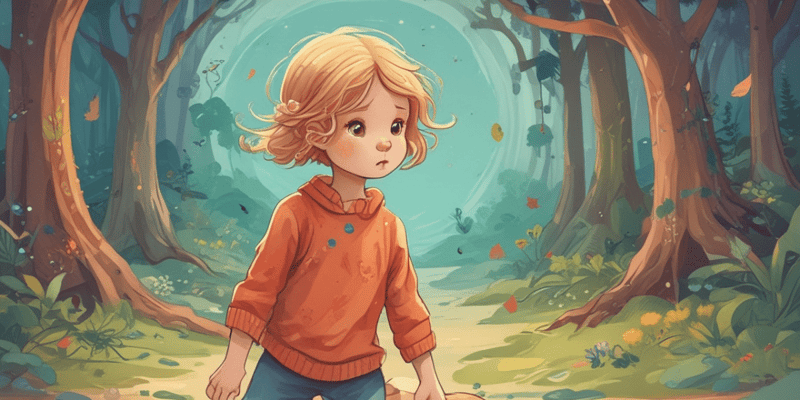12 Questions
Which intelligence is associated with the ability to visualize objects and solve problems using spatial reasoning?
Spatial intelligence
According to Howard Gardner's theory, which of the following is NOT one of the multiple intelligences?
Emotional intelligence
What is the term used to describe the intelligence associated with natural athletic abilities?
Bodily-kinesthetic intelligence
Which intelligence is characterized by an inherent understanding of rhythm, pitch, sounds, and melody?
Musical intelligence
What is the term used to describe the intelligence associated with an intuitive understanding of mathematical and logical concepts?
Logical-mathematical intelligence
Which intelligence is related to being in touch with oneself?
Intrapersonal intelligence
Which of the following is NOT one of the primary learning styles mentioned in the text?
Tactile
Which of the following personality traits is NOT mentioned as important for a child's development?
Ambition
Which of the following is NOT listed as a benefit of encouraging creativity in children?
Increased academic performance
Which of the following is a strategy for nurturing emotional intelligence in children?
Practicing active listening
Which of the following is NOT one of the multiple intelligences mentioned in the text?
Linguistic
What is the purpose of understanding a child's preferred learning style?
To design instructional methods that cater to their individual needs
Study Notes
Introduction
Children possess a range of strengths, abilities, and talents that contribute to their overall development and success. These qualities encompass various aspects such as cognitive abilities, learning styles, personality traits, creativity, and emotional intelligence. Understanding and nurturing these strengths can significantly impact a child's growth and well-being. In this article, we will delve into the concept of multiple intelligences, learning styles, character strengths, creativity, and emotional intelligence in children and explore strategies to foster and enhance their development.
Multiple Intelligences
Harvard psychologist Howard Gardner posited the theory of multiple intelligences, suggesting that individuals possess different intellectual strengths. These intelligences are categorized as follows:
- Spatial: the ability to visualize objects and solve problems using spatial reasoning
- Bodily-kinesthetic: natural athletic abilities
- Musical: inherent understanding of rhythm, pitch, sounds, and melody
- Linguistic: skill with words, language, and communication
- Logical-mathematical: intuitive understanding of mathematical and logical concepts
- Interpersonal: ability to relate to people
- Intrapersonal: being in touch with oneself
- Naturalistic: the ability to appreciate nature, plants, and animals Identifying a child's natural aptitudes within these categories can guide parents and educators in supporting their growth and development in fields aligned with their abilities.
Learning Styles
Every child has a unique way of processing information, which influences their learning style. Broadly speaking, there are three primary learning styles: auditory, visual, and kinesthetic. Understanding a child's preferred learning style can help educators design instructional methods that cater to their individual needs. For instance, auditory learners benefit from lectures, verbal explanations, and discussions, while visual learners prefer diagrams, images, and videos, and kinesthetic learners respond best to hands-on activities.
Personality Traits
Personality traits play a significant role in shaping a child's behavior and interactions with others. Key traits include honesty, kindness, cooperation, and empathy. Nurturing these traits can enhance a child's relationships and emotional intelligence. Additionally, promoting a sense of independence and resilience can equip children with essential skills for coping with adversity and navigating life's challenges.
Creativity
Creativity refers to the ability to generate novel and imaginative ideas. Encouraging creativity in children can have numerous benefits, including improved problem-solving skills, enhanced critical thinking, and increased self-esteem. Strategies to foster creativity include providing opportunities for free play, engaging in open-ended activities, and modeling creative behaviors.
Emotional Intelligence
Emotional intelligence involves awareness and management of one's own emotions and the ability to understand and respond appropriately to the emotions of others. Cultivating emotional intelligence can lead to stronger interpersonal relationships, improved conflict resolution, and enhanced overall well-being. Techniques for nurturing emotional intelligence include practicing active listening, expressing empathy, and regulating one's own emotions.
Conclusion
Recognizing and nurturing children's strengths, abilities, and talents is crucial for their overall development and success. By understanding multiple intelligences, learning styles, character strengths, creativity, and emotional intelligence, parents and educators can create targeted strategies to support each child's unique journey towards growth and achievement.
Explore the concepts of multiple intelligences, learning styles, personality traits, creativity, and emotional intelligence in children, and learn strategies to nurture their strengths for optimal growth and well-being.
Make Your Own Quizzes and Flashcards
Convert your notes into interactive study material.




